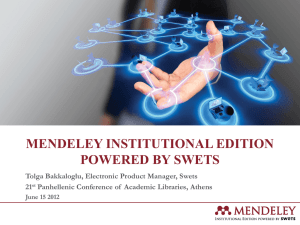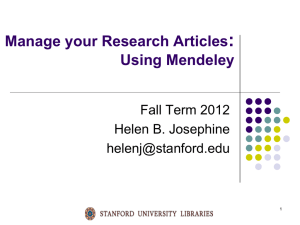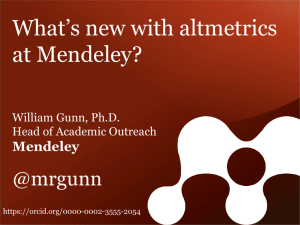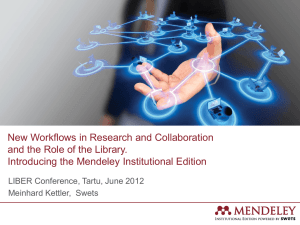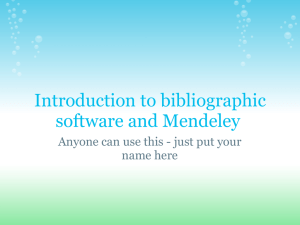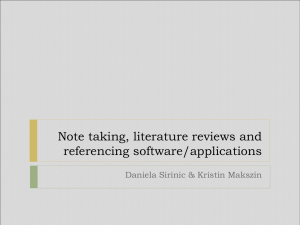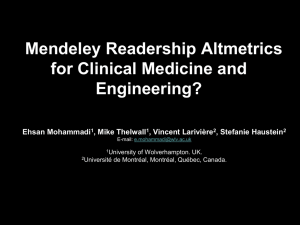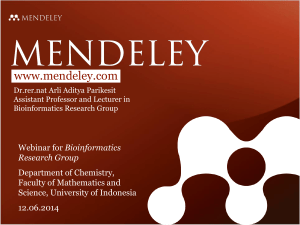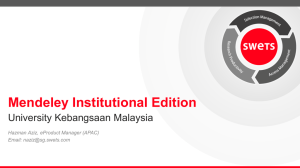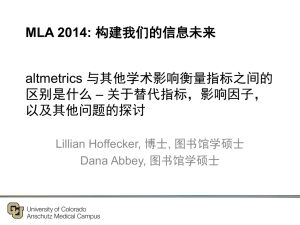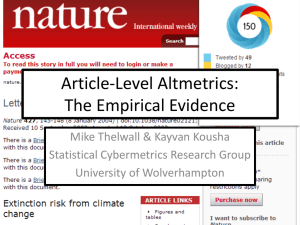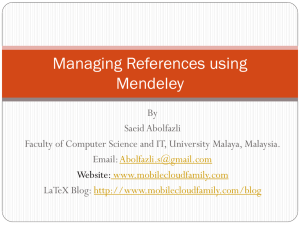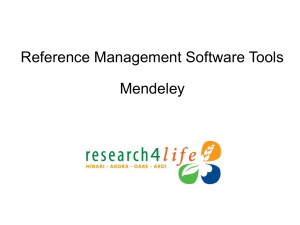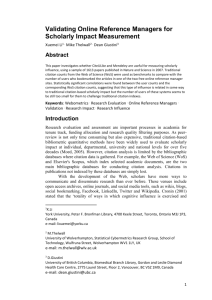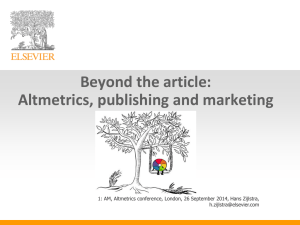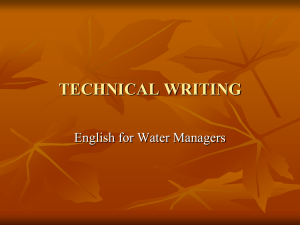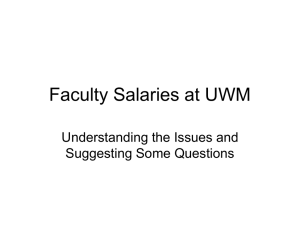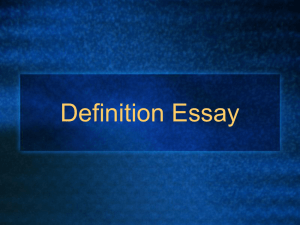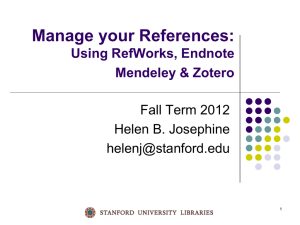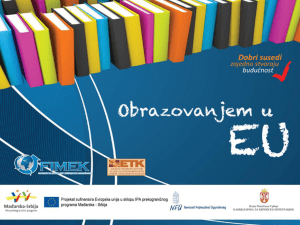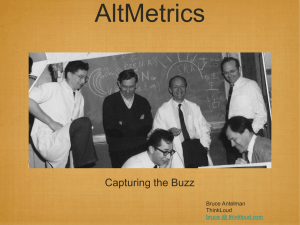Could they be - Article Level Metrics
advertisement
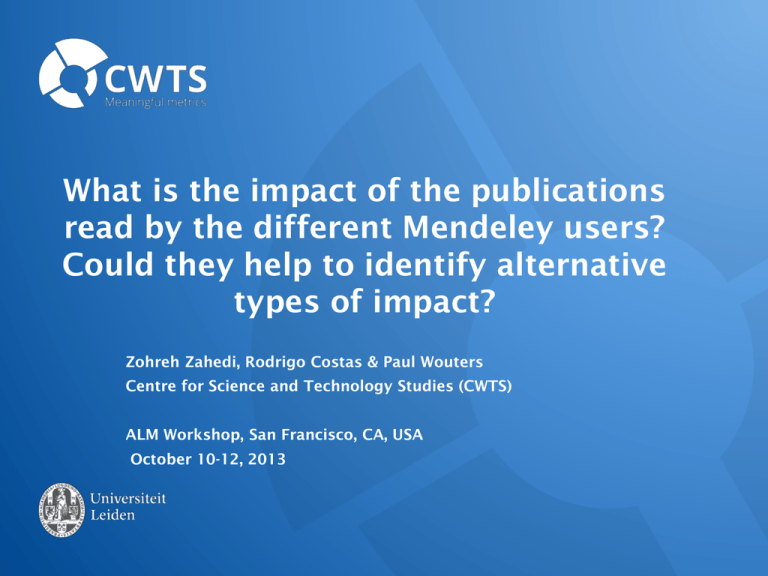
What is the impact of the publications read by the different Mendeley users? Could they help to identify alternative types of impact? Zohreh Zahedi, Rodrigo Costas & Paul Wouters Centre for Science and Technology Studies (CWTS) ALM Workshop, San Francisco, CA, USA October 10-12, 2013 Outline • Introduction • Objectives • Research Questions • Methodology • Findings • Conclusions, Discussions & Limitations 1 Introduction Altmetrics Tools: Mendeley , Impact Story , altmetric.com, PLOS ALM, F1000, Plum Analytics, …. 2 Previous research Altmetrics & Citation Correlation: Henning (2010);Priem, Piwowar & Hemminger (2012); Bar-Ilan et. al. (2012a & 2012b); Li, Thelwall & Giustini (2012); Li & Thelwall (2012); Zahedi, Costas & Wouters (2013); Mohammadi & Thelwall (2013); Schlögl et. al. (2013); Haustein et.al. (2013a & 2013b) Altmetrics & Citation as predictors: Wardle, 2010 Eysenbach, 2011 Waltman & Costas, 2013 3 Objectives & Research Questions: To distinguish patterns in terms of impact depending on the types of Mendeley users Q1. What do the different Mendeley users read in terms of document types and Subject fields? Q2. To what extent do the readerships of the different users in Mendeley correlate with citation indicators? Q3. What is the impact of publications read by different users in Mendeley? 4 Methodology (1) Random Samples: 1. 20,000 WOS publications from all disciplines between 2005-2011 2. 200,000 WOS publications from all disciplines between 2011-2012 Metrics: Mendeley & Impact Story APIs 5 Methodology (2) Collecting altmetrics on the basis of DOIs of the publications Using Mendeley & Impact Story APIs Linking and matching with WOS Adding bibliometric indicators Analyzing the data 6 Types of Mendeley users • Professors (Associate, Assistant) • Lecturers (Senior) • Postdocs • Researchers (Academics/non-Academics) • Students (Bachelor, Master, Postgraduate) • PhD/Doctoral • Librarian • Other professionals • Unknown 7 Distribution of readerships in the samples by types of users Sample 1 3% 1% 0.3% Unknown 5% Students 7% 33% 10% Sample 2 PhD PostDocs Researchers 4% 3% 0.9% 0.4% 7% 34% 10% Professors 13% 28% Other Professionals Lecturer 17% 25% librarians 8 Modeling impact by Mendeley users: Scientific: Professors, PhD, Postdocs, Academic Researchers Educational: Lecturers, Bachelor, Master & Postgraduate Students Professional: Librarians, Other Professionals, non Academic Researchers Unknown: unidentified users Sample 1 Sample 2 SCIENTIFIC READERS 28% EDUCATIONAL READERS 53% 5% 14% PROFESSIONAL READERS Unknown 25% 5% 52% 18% 9 What document type are more read by the different users? (sample 1) 40% PhD 35% Unknown Professions 30% Students 25% PostDoc 20% Researchers Professors 15% Other Professionals 10% Lecturers 5% Librarians 0% Articles Reviews Non Citables Letter 10 Which fields are more read by types of users?(sample 1) 45% 40% 35% PHD Unknown 30% 25% 20% 15% 10% Students PostDocs Researchers 5% 0% Professors Other Professionals Lecturers librarians 11 Which fields are more cited/read per publication?(sample 1) 45 40 35 30 25 20 15 10 5 Readers per Paper (RPP) Citations per Paper (CPP) 0 12 Which fields are more cited/read per publication? (sample 2) 8 7 6 5 4 3 2 1 Readers per Paper (RPP) Citations per Paper (CPP) 0 13 To what extent do the different types of users in Mendeley correlate with citation indicators? Correlation Sample 1 Sample 2 Professors Other Professional Librarian Readers Unknown PhDs PostDocs Students Researchers Lecturers 0,52 0,51 0,46 0,43 0,34 0,15 0,09 0,02 -0,01 -0,01 0,35 0,33 0,29 0,24 0,22 0,1 0,03 0,04 -0,01 -0,01 Citations Correlation Sample 1 Sample 2 Readers Unknown Scientific Educational Professional 0.52 0,51 0,48 0.34 0,05 0,35 0,33 0,30 0.21 0.07 Citations 14 What are the impact of publications read by different types of readers? 25% PP Top 10% 20% 15% 10% Sample 1 sample2 5% 0% 15 Limitations • Access only to the top 3 categories of readers in Mendeley • Data collection (time consuming) • Speed of use the APIs (API limit) • Scalability (limitations for the medium-large scale analysis) • Not perfect data matching with WOS (DOIs, ….) 16 Conclusions & Discussions • Potential advantage of Mendeley over citations: – for publications from social sciences and humanities – for recent publications [!] • Scientific users are more correlated with citations than educational and professional users • The other users could help to identify other types of impact: educational, professional [?] • Some users tend to read more highly cited papers than others: Postdoc, PhD Students vs Professors • Identifying the unknown users can shed some light in detecting these other types of impact • Further analysis needs to be done to dig into the content of reading by different types of users 17 Thanks for your attention! z.zahedi.2@cwts.leidenuniv.nl 18
